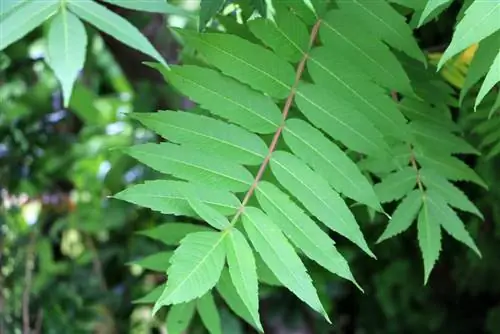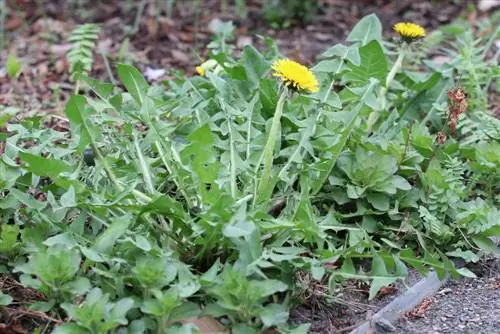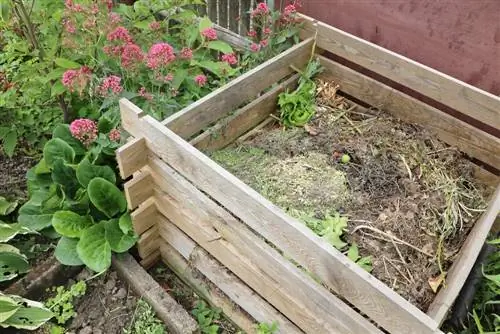- Author admin [email protected].
- Public 2023-12-17 03:39.
- Last modified 2025-01-24 12:45.
The plant with the feathery leaves is an attractive beauty in your own garden thanks to its distinctive autumn color. However, if planted carelessly and without preparation in your own garden, the ornamental tree from North America can quickly become a real pest. In order not to have a forest of vinegar trees right on your doorstep within a few years, necessary steps should be taken to combat the stubborn urge to reproduce. Getting rid of the vinegar tree or at least keeping its fast-growing offspring in check is easy.
Fascinating beauty with fatal consequences
The deciduous shrub belongs to the sumac family and is a popular ornamental tree in numerous gardens and parks. The multi-stemmed tree, which grows up to 12 meters high, has impressive orange to fiery red leaf coloring in autumn. And the bulb-shaped fruits also bring life into the otherwise dreary winter landscape with their purple color. But as fascinating as the external appearance of Rhus typhina may be, the cultivation of this plant also has its downsides. The vinegar tree is surrounded by a densely branched network of roots, which in older specimens can reach a diameter of up to 6 meters. If the North American ornamental trees feel comfortable in the selected location, the plants' strong desire to reproduce becomes apparent as early as the second or third year. Between 20 and 30 shoots every year literally shoot out of the root system and spread uncontrollably throughout the garden. Quick help is advisable if you don't want to find yourself in a forest of vinegar trees soon.
Pruning the vinegar tree
The vinegar tree is a relatively undemanding plant that grows quickly even in a nutrient-poor substrate. By radically pruning the tree itself, you cannot stop the development of root runners. Rather, this measure will destroy the characteristic shape of the ornamental tree. Only cross-growing or dead shoots are regularly removed from older trees. However, you can definitely tackle the shoots themselves with a saw or scissors.
- Pruning shears or saw
- Gloves
Cut off the root runners surrounded by brown raffia close to the ground, which can also protrude from the ground several meters away from the vinegar tree. When in direct contact with the plants, you should wear long-sleeved clothing and gardening gloves. The plant sap can cause skin irritation and respiratory problems in sensitive people. In this case, do not dispose of the cut shoots in the compost, but directly in the household waste. Some gardeners also tend to cut off emerging shoots with a lawnmower. However, this method can damage the mowing deck of your machine and only weakens the tree to a limited extent. The shoots of the vinegar tree sprout vigorously in another place.
Tip:
Make sure that rodents living in the garden, such as guinea pigs or rabbits, do not consume vinegar tree leaves. This can lead to the death of your beloved four-legged friends.
Proper removal instructions
Mechanically removing the young shoots only gives you a short break. Throughout the summer, the vinegar tree sprouts in a variety of places. Even gravel paths do not pose an obstacle for the plant. In order to protect your garden from the reproductive tree in the long term, other measures are necessary.
- Remove the soil around the vinegar tree.
- Remove all visible root suckers.
- Sift the substrate before filling it back.
This method is strenuous and may need to be repeated after 2 to 4 years. Since the vinegar tree has shallow roots, it is sufficient to remove the sprouting root shoots if you only remove the soil to a depth of 30 centimeters. A mini excavator or an extra pair of helping hands will make your work easier. If you want to completely destroy the vinegar tree, you cannot avoid removing the soil. First, fell the tree and dig up the stump and rootstock. This shows that even shallow-rooted trees form a root network that is over 2 meters deep. Using a sturdy spade or a mini excavator, you can also try to lift the tree stump and most of its roots out of the ground. You can achieve optimal leverage when at least 1.50 - 1.80 meters of the tree trunk itself is still available. Even if this campaign was successful, the same applies here: If you do not want to fight the shoots of Rhus typhina in the coming years, you must carefully remove even the smallest root residues from the soil. Because even root pieces just a few centimeters in size are enough to form a new generation of vinegar trees.
Aggressive means as a last resort

It may be tempting to try to permanently damage the underground parts of the plant with household remedies or even fire. However, this type of removal involves risks and can cause long-term damage to the garden. Vinegar and s alt are almost indispensable ingredients in the home kitchen, but these two components have no place in the outdoors to combat annoying plants. The same applies to magnesium, which careless gardeners occasionally sprinkle into the cavities of the trunk and then set on fire. Avoid this type of destruction. If neither permanent pruning nor digging out the root runners brings any visible success, you can also use herbicides from specialist retailers. Be careful when handling chemical products and strictly follow the instructions for use. The chemical agents attack the unwanted plants directly and destroy them completely. However, if used improperly, beneficial insects and other animals can also be harmed by the ingredients.
Tips for stress-free cultivation
In order to still cultivate the attractive ornamental tree in your own garden, you should take some measures against the stubborn root system before planting. The pressure exerted by the underground parts of the plant is great: the North American plant also manages to easily lift away paving slabs and damage underground pipes. Contain excessive root growth with a barrier. The root barrier itself consists of a stable pond liner, which the vinegar tree itself cannot penetrate.
- The soil is removed to a depth of 60 centimeters with a diameter of 4 to 5 meters.
- Line the inner edge of the pit with a pond liner approximately 5 millimeters thick.
- Weld or securely glue the transition between both ends.
- Enrich the excavated earth with humus and fill it back.
A weak point is the fold where the two ends of the pond tarpaulin meet. Here you should take the greatest care when processing it. Even the smallest holes are enough to give the roots of the vinegar tree access to the rest of your garden. In this case, the work would have been in vain and you would always have to mechanically remove the newly sprouting shoots. The North American plant can also be cultivated in bonsai format. The maintenance effort is much higher here, but your garden is spared from the young shoots.
Conclusion
If you want to plant a vinegar tree in your own garden, you should think carefully about this step. Because the shoots that sprout within several meters are stubborn. As soon as one spot has been sufficiently cleared of the rampant shoots, they sprout again in another spot in the garden. It is worth taking precautionary measures in the form of a root barrier before the vinegar tree can develop its extensive root system. The cutting and mechanical destruction of the shoots is relatively simple, although short-lived.






